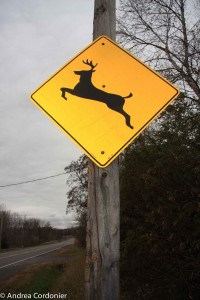 On Sunday night, just after dark, we were heading home along our usual route with Husband in the driver’s seat. We were travelling at ‘rural’ speed, par for the countryside, but not terribly wise for this time of the year. Being the passive, obedient wife that I am (snort!) I resisted the urge to remind Husband to slow down. Sure enough, just around the next turn, two cars were pulled off on the side of the road. One of them had struck a deer.
On Sunday night, just after dark, we were heading home along our usual route with Husband in the driver’s seat. We were travelling at ‘rural’ speed, par for the countryside, but not terribly wise for this time of the year. Being the passive, obedient wife that I am (snort!) I resisted the urge to remind Husband to slow down. Sure enough, just around the next turn, two cars were pulled off on the side of the road. One of them had struck a deer.
It appeared there were no injuries, save for the poor beast, so we drove on to J. and C.’s place a short way up the road. They are local food aficionados and, as J. and I had recently retrieved and butchered a six-point buck that had met a similar fate, I knew they’d be interested. J. phoned an hour later to say that they did go up to check it out, but that the person that hit it had already called a friend to come out and help. At least it was being used, she said, unlike a young doe that she had seen laying nearby a few days earlier.
It may seem like an obvious point to make, but here it is anyway: There’s a reason why there are leaping deer signs posted on this and so many other rural and suburban roads. They aren’t put there as a suggestion, but to flag drivers that large wild animals will likely play ‘chicken’ with moving vehicles during certain times of the year. One strategy is never to leave downtown. But as urban housing sprawl continues to creep into the greenbelt, encroaching on natural habitats, accidents like this will become more common. It is brutal for the animals involved and can be equally deadly for automobile passengers (Google YouTube+car accidents with deer for a graphic example or thirty). According to the Ontario Ministry of Transportation:
- On average, there is a motor vehicle/wild animal collision every 38 minutes
- One out of every 17 motor vehicle collisions involves a wild animal
- Motor vehicle/wild animal collisions are increasing annually. In 2007, 13,954 collisions were reported. Many more go unreported.
- 89 per cent occur on two-lane roads outside of urban areas
- 86 per cent occur in good weather
The two highest risk periods are April to May and October through January. November is the worst. The Ministry recommends to:
Watch
- Scan the road ahead from shoulder to shoulder. When you see wildlife beside the road, slow down and pass carefully as they may suddenly bolt onto the road.
- Watch for the yellow wildlife warning signs that indicate an area of increased risk. Slow down when travelling through these areas.
- Use high beams at night where possible and watch for glowing eyes of animals
Steer
- Stay in control. Watch your speed and take extra precautions when driving at night as visibility is greatly reduced. Slowing down will give you that extra second to respond.
- Never swerve suddenly. This could cause your vehicle to go out of control or head into oncoming traffic.
Brake
- brake firmly if an animal is standing on, or crossing, the road. Never assume the animal will move out of your way.
Stop
- Stop as safely as possible if a wild animal is crossing the road. Remember, if one animal crosses the road, others may follow.
And if striking a largish animal is unavoidable, here’s what to do:
- Pull off the road.
- Turn on hazard lights.
- Illuminate the animal with your headlights.
- You may choose to carefully approach the animal to determine if it is dead or injured.
- If it is injured, back off. A wounded animal can be very dangerous. You are not required to put an injured animal out of its misery.
Once an animal is dead, however, it is fair game for the Road Kill Cafe.
*****************
“Road kill is the only sustainable meat.” – Tweet, Nov 1/2011; attributed to a well-known anti-factory farming advocate
Is it possible that with the spike in popularity with urban foraging that stalking and claiming road kill will be the next logical trend in local food? It has the perfect competitive smell to it, great photo ops, and is taboo enough to make you queen or king of the drinks circuit for fifteen minutes or so. Here’s a sample of the potential conversation:
“Oh, I absolutely agree. Your hand-fed with hazelnuts and beer-massaged organic beef that was euthanized to the sounds of Brahms is delicious. But you simply must try our deer/bear/squirrel/beaver hot pot, made with the delicious fruits of dear Jules’ recent rural foray. Then little Farrah can show you the divine boots she fabricated from the skins, in consultation with her Harvard-educated Sustainable Fine Art and Crafts Yogi.”
I can already imagine the GPS-chipped flags for staking one’s claim and the app for geo-identifying potential treasures on those long road-trips. They could be added to FourSquare and you could become Mayor of the Dead Skunk on Highway 416 at Hunt Club.
Wikipedia has a slew of excellent resources on the subject should you wish to jump on the speeding bandwagon.